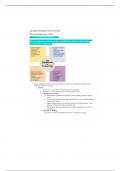Sunyoung FINAL blueprint NUR 211 FALL 2022
50 items (46 multiple choice; 4 Math)
Schizophrenia-------------------------------10 items
(Communication techniques, positive/negative symptoms of schizo, atypical (Example: Seroquel) & typical
antipsychotics (Example: Thorazine and Haldol) anti-psychotics/side effects (NMS, EPS (treatment Ex:
Cogentin, Benadryl), patient teachings.
Positive symptoms (alterations in thinking, (delusions); alterations in perceptions (hallucinations),
alterations in behavior (catatonia)
o Positive:
Appear early in acute phase, usually precipitate hospitalization
Respond very well to medication, least important prognostically
Alterations in perception
Hallucinations: auditory (most common), visual, gustatory, olfactory, somatic-
tactile
Command hallucinations: most dangerous, must assess. Voices could be telling pt
to harm self or others
Depersonalization: person has lost their identity, self is different/unreal – body
parts don’t belong to them, they are another race
Derealization: false perception that environment has changed – ex we are in a
spaceship now
Alterations in Thinking
Delusions: false fixed beliefs that cannot be corrected by reasoning
, Thought broadcasting, thought insertion, thought withdrawal, delusion of being
controlled, concrete thinking
Impaired reality testing: can’t correct errors in thinking
Alterations in Behavior
Loss of impulse control can lead to agitated behaviors
Bizarre behaviors: eccentric dressing, rigid behavior, strange grooming or rituals,
aggressive/agitated behavior, social/sexual behavior
Extreme motor agitation: running, pacing, can become harmful to self or others
Stereotyped behaviors: motor pattern that once had meaning but no longer does
(ex: ex window cleaner repetitively cleans windows)
Catatonia
o Waxy flexibility: excessive maintenance of posture, pts holds unusual
poses for long periods
o Stupor: catatonic pt is motionless for long periods, may appear to be in
coma
o Negativism: active negativism pt does opposite of what is told to do //
passive negativism is when pt does not perform normal expected activities
(eating, getting out of bed)
Alterations in speech patterns
Associative looseness: very common – no connection between topics talked about
Neologisms: made up words by pt that have special meaning to person who made
them up
Clang association: meaningless rhyming of words
Word salad: jumbles of words that become gibberish
Echolalia: pathological repeating of another’s words
Echopraxia: mimicking movements of another
o Both Echoes common in catatonia
o Negative:
, Typically develop insidiously over a long period of time and difficult to assess during
acute psychotic episode
Most intrusive to pt quality of life and ability to survive; inability to maintain
relationships/convos means they have a hard time getting jobs, making decisions,
maintaining hygiene/grooming
Affective blunting: reduction in expression in emotions, eye contact, bland speech (A
blunted or flat affect can occur as part of the negative symptoms associated with a
thought disorder)
Alogia: aka poverty of speech – restriction in amount of speech, brief answers
Anergia: no energy, passivity
Avolition: lack of motivation
Apathy: lack of interest/care
Anhedonia: inability to feel pleasure
A sociality: inability to socialize with others productively
Mood Disorder: Depression--------------10 items
Communication techniques, patient teachings; antidepressants: MAOI, TCA, SSRI- side effects and teachings)




